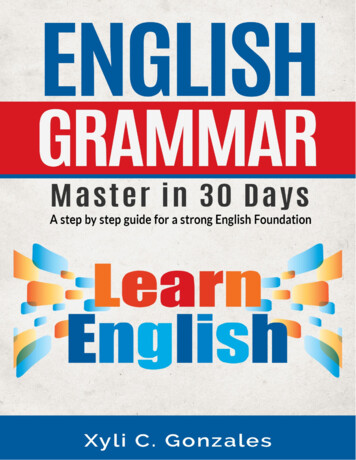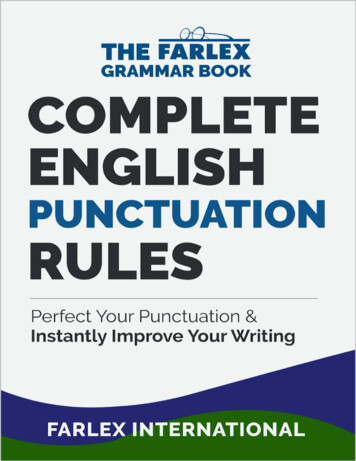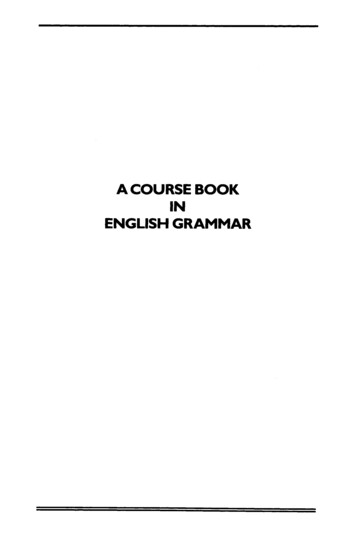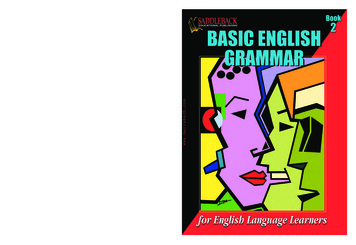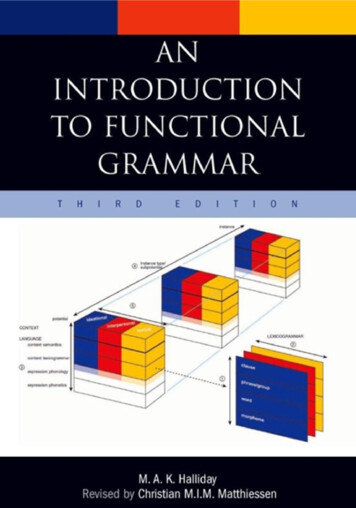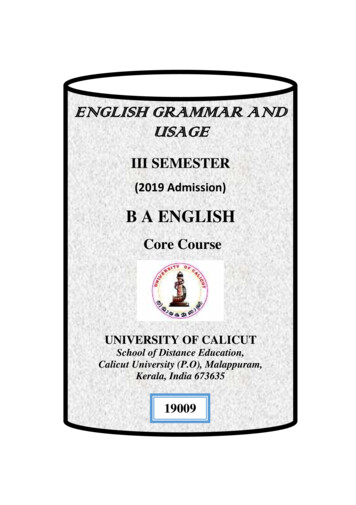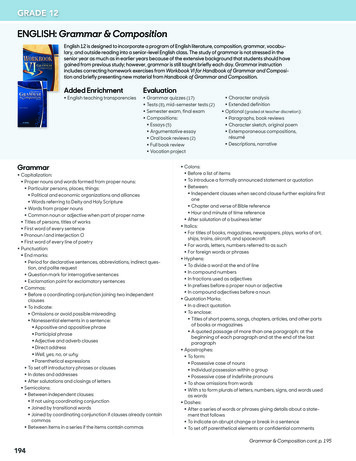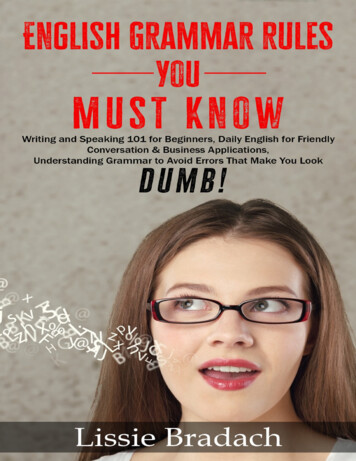
Transcription
English Grammar Rules You MustKnow:Writing and Speaking 101 for Beginners,Daily English for Friendly Conversation& Business Applications, UnderstandingGrammar to Avoid Errors that Make YouLook DumbLissie Bradach
Table of ContentsIntroductionChapter 1: Welcome To English GrammarChapter 2: NounsChapter 3: VerbsChapter 4: PronounsChapter 5: Adjectives And AdverbsChapter 6: Articles And ParticlesChapter 7: PrepositionsChapter 8: ConjunctionsChapter 9: Synonyms, Antonyms, and HomonymsChapter 10: PunctuationChapter 11: Sentence StructureChapter 12: The ParagraphChapter 13: The EssayConclusion
IntroductionCongratulations on purchasing English Grammar Rules You Must Know:Ultimate Grammar Writing and Speaking 101 Workbook for Beginners,Daily English for Friendly Conversation and Business Applications,Understanding Grammar to Avoid Errors that Make You Look Dumb, andthank you for doing so.The following chapters will discuss the rules of English Grammar and howyou can use the English language in your daily life situations. You will learnthe different types of words in the English language and their most commonuses and show you mistakes commonly made, so you don’t make these samemistakes.Although it has its little quirks, the English language is complicated to learn.After all, the word ‘hot’ can refer to the room temperature, the food'stemperature, the food's spiciness level, or the good-looking person who justwalked by the window. And hot is a word that you would use in youreveryday speech, as long as you know the context and use it correctly. Thereis also the kind of English grammar spoken in more formal situations, likechurch, the office, or meeting your significant other's parents for the firsttime.The English language has been changing and evolving for centuries. TheEnglish grammar used by the original people who spoke English is quitedifferent from that said today. The actual language started as a mixture ofmany other languages in the same region and developed into another new andfresh language. As even more people from different places on the map movedinto the area, they all brought with them their unique language, to add it tothe melting pot of languages that evolved into the English language.Part of the things that make up English grammar known today came aboutbecause of historical changes. The advent of the dictionary and printed wordhad a significant effect on the English language. As the world changed andpeople became more mobile and more fluid, so did the English language. Thegrammar that came out of that language is the subject of this book, and it isall covered in-depth, in great detail, with examples wherever possible of theright way and the wrong way to use the English language and Englishgrammar.
Most of the English language will follow the same set of rules most of thetime. As long as you understand the essential parts of speech and how to putthem together in a verbal or written context so that they make sense, then youwill have won the battle and conquered the English language and its grammarrules. And that is what this book is here to help you do: use the Englishlanguage correctly and adequately (there is a difference between the two!).As long as you follow the basic rules for grammar and the rules for using aparticular form of grammar, you will be just fine.This book will help you, whether you are a native English language speakeror are new to the language, learn all of the information you need to speak andwrite the language correctly and adequately. Some of the information youwill find in this book is not well known, but it is required for you to have agood command of English grammar. You will learn about the nouns andverbs that form the language's building blocks, those words that all sentencesrequire one of, and that all sentences contain. You will also see a discussionof the other terms in the English language, the adjectives, pronouns, adverbs,synonyms, and antonyms that add color and fluff to plain speaking andwriting. While it is essential to know the basics and how to use them, it is justas crucial for you to understand how to decorate your speaking and writing toadd more enjoyment to your English language command.There are numerous books on English grammar and the English language onthe market, so thank you for choosing this one! This book is full of as muchuseful information as was possible to put into one book, so please enjoy it!
Chapter 1: Welcome To English GrammarGrammar rules are nothing more than grammar rules; the guidelines tell youhow you should speak and write a particular language. Even though thinkingabout grammar rules might remind you of endless boring sessions inelementary school, grammar can be a fun subject. English grammar laws areuseful for knowing how to speak and write the English language effectivelyand confidently. Grammar rules tell you how to use words and sentences in auniversally accepted manner as grammatically correct. The grammar rules ofany language reflect the nature of the structure of the language. Rules ofgrammar don’t apply to just the words of the language, but they also apply tothe punctuation and creative use and the meaning of the words and usingthem in the proper context.You will communicate better if you understand the rules of grammar. Therules for using words and forming phrases and sentences will help you speakand write in a manner that other people understand and can enjoy. Knowingthe parts of grammar and their primary uses are also vital for analyzing howyou use the English language and improving your writing and speaking. Thewritten word is often prone to improper grammar usage. While spoken wordwill sometimes relax the rules regarding the proper use of grammar, there arecertain situations in which a more formal tone is desirable.The Origin of the English LanguageAs it is now, the English language has undergone many changes in thecenturies it has been in use. It is believed the English language began with thearrival of three separate Germanic tribes that invaded Britain during the fifthcentury. Germanic refers to people who lived in the upper half of Europe atthat time. When they invaded Britain, they pushed the people who spoke theCeltic languages into the area that is now Ireland and Scotland. The threetribes spoke similar languages that eventually merged into what is known asOld English. Someone from today who traveled back in time would havedifficulty speaking English to someone who spoke only Old English.In the eleventh century, England was invaded again by people from Europe,who is now France, who brought their language. They spoke a languagesimilar to French and became the accepted language among royalty, business
people, and the ruling class. The lower classes still spoke Old English, socommunication between the two types was rather tricky. By the fourteenthcentury, the French language had virtually disappeared, except for someparticular words, and the two languages merged and created Middle English.This language was Shakespeare and Chaucer's speech, but it would also bedifficult for someone of today to understand.Around the nineteenth-century, Middle English began to change. The mostsignificant change was that vowels became shorter for some unknown reason.This change brought even more new words into the English language. Thisperiod was also when the printed word became common, so that it wasnecessary to have one common language for printing purposes. This reasonmade the English language more standardized, with the rules for spelling andgrammar fixed into place. Since London was the location of most publishinghouses, the dialect of that city became the norm, and in 1604 publishersprinted the first dictionary of English words, and Early Modern English wasborn.The vocabulary was the most significant difference between Early and LateModern English. There are many more words in the collection of words thatmakes up Late Modern English for two specific reasons. The first reason isthe Industrial Revolution, which created many new words to add to theEnglish language. The second reason is that the British Empire occupiedabout one-fourth of the world's surface with its extensive holdings. TheEnglish language incorporated many foreign words into daily use.American English is quite different from modern British English. It is closerto Shakespearean English with its use of certain words and how they functiontogether. When the colonies were founded, they used this form of the Englishlanguage, which became modern American English. The language was alsoinfluenced by some of the different groups that came to North America, somodern American English uses words originating from Spanish, French, andWest African influence.Conversational Grammar Usage RulesConversational English is the form of the English language spoken daily byregular people doing everyday things. It is using a common language withcommon daily expressions. It is the form of the English language that is
learned by small children hanging around adults. There are no problematicterms or formations needed in conversational English. Sometimes completesentences are not required. Imagine hearing a conversation like this one?Person A: Where you going?Person B: Store. Wanna come?There is nothing proper or correct about that little exchange; it is just twopeople having a short conversation. Conversational English does not need tobe grammatically correct because people having a relaxed discussion are notconcerned with grammar rules. This explanation is why it is difficult forthose who are not native English speakers to learn to speak English only fromdaily conversations with other people. When people who are not nativeEnglish speakers begin to learn the language, they learn all of the grammarrules to discover that most people don’t talk that way in daily conversation.The laws of grammar are less critical when the conversation is in an informalcontext.When several people have a conversation, it is common to find moregrammar rules broken than not. Real people use pronouns the wrong way,speak in fragments of sentences, and utilize contractions as often as possible.They speak in shorter sentences that are usually to the point without a lot ofdescription. Every person has a unique style and rhythm for speaking.Informal communication occurs with little to no regard for the rules ofgrammar.Formal Grammar Usage RulesBusiness grammar is quite different from conversational grammar. The wordsare the same, and they have put together in much the same manner, butbusiness grammar is much more formal than conversational grammar.Knowing and using business grammar or proper grammar is just as importantas wearing the right clothes in a business or traditional setting. And the waybusiness English is spoken is slightly different from conversational English.Business English requires a more formal approach to putting words togetherand what they mean when they appear together. Sometimes conversationalEnglish is wide open and unrestricted. Business English needs to be politeand proper. Here is an example of the difference.
Conversational: She hasn’t sent the email.Business: The email has not been sent yet.The speaker is somewhat blaming one person for not sending the email in theconversational version, but the idea is not to blame in the business version.By wording the same thought differently, the attention is shifted to the act,the fact that the email hasn’t been sent, not focusing attention on the personwho has failed to send it. This technique is essential for avoiding placing theblame on one person. You use this when it is not important who made amistake, and you need to keep the tone of the conversation more formal.Formal speech is always less personal than conversational speech.Another distinction for business English is the tendency to use certain wordsin place of similar words to convey a specific meaning. The terms may andmight have roughly the same meaning:I may go to the store. I might go to the store.In the business world, the words have different connotations (inferredmeanings) and are not interchangeable. The word might sound weaker thanthe word may.Sales may recover this weekend. Sales might recover this weekend.The first sentence is a much more positive-sounding sentence than the secondone. Much of the conversation is carefully worded in the business world tomake the situation sound better than it might be. In conversational English,the goal is to exchange information. In business English, the goal is toexchange information while maintaining a certain level of etiquette. Anothermanner in which the two differ is how you express the idea.Conversational: They are still in the meeting. Something’s wrong.Business: They are still in the meeting. Something must be wrong.Both thoughts say the same thing, but the business example says it with a bitmore formality than the conversational version. This example will show thedifference between conversational English and business English.Conversational: Can you work for me today?Business: Could you work for me today?
Both ask the same question, but the business version is more formal. Themost important thing to remember about traditional business English is that itis just as crucial to your career as wearing the right clothes, getting a goodeducation, and knowing a particular skill. You will be judged in the businessworld by the way you communicate verbally. That sentence could have endedwith ‘the way you talk’ but ‘communicate verbally’ sounds so much moreproperCorrect Grammar v. Proper GrammarThere are correct grammar and grammar that are proper, and they are not thesame thing. Either word will function as an adjective in speech. The wordcorrect means that something is free from error, and proper means that it issuitable or acceptable for that circumstance or purpose. You can be accuratebut not appropriate. You can make a correct statement, as far as grammar isconcerned, but it might not be proper for the situation. Example:“You are free to go to the ballgame this weekend, correct?”This question shows one person asking another person if they will be able togo to the ballgame over the weekend, as long as they have no othercommitments. The question is grammatically correct, but this would not beproper if asked in the middle of a monthly sales meeting at work. Talkingabout personal plans is best left to the lunchroom.Correct is the answer if someone wants to know if a particular thing is theright thing to be used or said in that situation, such as the correct haircut, thecorrect shoes, the correct answer. Use proper if someone wants to know if aparticular thing is appropriate for the situation, such as proper knowledge,proper behavior, and proper seating arrangements.But the situation can get a bit more complicated. Sometimes the words areinterchangeable, and this might change the meaning of the sentence.The correct haircut is one that is proper for the dress code.A proper haircut is one that follows the dress code correctly.The correct answer fits properly in the number of spaces allowed.A proper answer will be the correct one.
Correct and proper have confused people since the dawn of time. When youare writing, experts say using a good grammar check program isrecommended, especially if you are writing a piece for work or school. Anyof the good ones will catch the misuse of these two words and prompt you tomake the sentence correct so that your word usage will be proper for thesentence.
Chapter 2: NounsOne of the first rules that every small child learns in a school setting is anoun. Every sentence you form correctly will have a noun as the subject ofthe sentence. You will use nouns for ideas, qualities, and states of existence.A noun is a part of a large open group of speech whose members often appearas the verb object, the preposition object, the main idea in the sentence, or thephrase or clause subject. A concrete noun names people, places, or the thingsyou can taste, smell, hear, and see. An abstract noun names emotions,concepts, and ideas, those things that you can’t taste, smell, hear, or see. Apronoun is not a noun.Proper NounThe names of the months, a person’s title, the days of the week, andorganizations, movies, newspapers, books, plays, and specific places areproper nouns. A proper noun is a particular type of noun that identifies onesingle thing and is used to refer to that one single thing, usually the name of aperson, their title, or a specific nsteinBradley ParkDisneylandMount VesuviusMary AnnHollywoodChips AhoyPurinaThis list is endless. A proper noun names explicitly a particular choice. It alsoadds interest to the sentence or story because it is so specific.I would like a cookie.I would like a Chips Ahoy cookie.Let’s go see someone.Let’s go see David.He drove to the city.He drove to Hollywood.My dog eats dog food.My dog eats Purina dog food.
The second sentence in each pair is much more enjoyable. You can govisiting, or you can visit David. You can go to the city, or you can go toHollywood. The idea behind using proper nouns, besides naming somethingin particular, is to make your conversation and your writing more interesting.Your friends might be interested in tales of your excursion to the city, butwhen you tell them you went to Hollywood, they will want details. And whowould like to eat just any cookie when someone offered a Chips Ahoycookie?Proper nouns are usually just one word, and sometimes they have theidentifier the in front of them to make the designation more specific, such asthe Doctor, the White House, or the United Kingdom. Proper nouns,including all proper names, are different from common nouns grammaticallyin the English language. Proper names used as titles:Mrs. Brown, Reverend Brown, President BrownUse a modifier as an adjective with a person’s title to add a bit of interest orcolor to the description:Cranky Mrs. Brown, old Reverend Brown, retired President BrownThe indicator might be used as part of the description when using a propernoun as part of an explanation:The old Reverend Brown, the retired President Brown I once worked forWhen you use a proper noun as part of a noun phrase, it must be considered afixed expression. Unlike a phrase which contains a common noun, nouns arenot modified internally:Common noun: beautiful old building can be changed to the old beautifulbuildingProper noun: the amazing Albert Einstein can’t be the Albert amazingEinsteinSometimes you will use a common noun as a proper noun. Some countrieshave an organization called the Office of Homeland Security, whichfunctions as the office of homeland security. You can use a location as aproper name, like when the road that winds around the lake is named Lake
Road or the street that passes the airport is called Airport Avenue.When you write the names of proper nouns, you will use a capital letter forthe first letter of any word that names something specific. If you don’t, thenthe meaning can completely change:The White House is the building in Washington, D.C.The White house is a house where the White family lives.The State of Minnesota denotes a particular state in the United States.The state of Minnesota sounds as though it is wondering how Minnesotafeels.Proper nouns are just as easy to use in your writing as common nouns are,and they will make your writing more interesting. Consider these examples:My best friend moved away.My best friend, Mary, moved away to live in London.The boy threw a ball to his dog.Gordon threw the ball to his dog Rover.We shopped at the furniture store and bought a mattress.We shopped at Birdwell’s Furniture Store and bought a Sleep Numbermattress.Common NounA noun used to name a general item, and not a specific thing is a commonnoun. There are common nouns everywhere in your life, and you use themdaily, even if you don’t think about it. Common nouns will not need to becapitalized unless they appear at the beginning of the sentence. A commonnoun can be used to refer to anything animate or inanimate, living ornonliving, or an abstract concept or idea. A common noun is the generalizedversion of the proper noun.I am planning to smoke some meat in the smoker this weekend.I am planning to smoke some meat in my WoodMaster Grill Smoker thisweekend.Both sentences are correct in the use of a smoker. If you are talking about a
generic smoker, you will begin the word with a lower-case letter. In thesecond sentence, you are using a specific name for the smoker's name, so theword smoker needs to be capitalized.You will use common nouns when you need to denote a concept or a class ofobjects. Anything that is a thing is generally classified as a common noun.You use common nouns when you speak about people in general and notabout specific people.You will use common nouns when talking about a specific profession, like afootball player, teacher, lawyer, doctor, nurse, politician, actress, etc. Sowhen you talk about the people in general, then you will use a common noun.You can refer to people using common nouns to describe them, like cousins,preachers, clerks, police officers, grandma, delivery drivers, barista,boyfriend, and girlfriend.If you are talking about your grandmother, then grandmother is a commonnoun.My grandmother is the best cook in the family.Bob’s grandmother lives next door to me.If you speak to your grandmother or use the word grandmother as part of hername, you will capitalize it and treat it as a proper noun.“Let’s go, Grandmother, the car is waiting.”We have Grandmother Smith as a guest for dinner tonight.Common nouns name objects, like a house, table, car, shoe, potato chip, soda,newspaper, etc.I read the newspaper every morning.My car is in the shop.I put the mail on the table.A common noun also names an abstract idea, something that is not a thingbut a concept such as an experience or an emotion like peace, anger,democracy, love, laughter, culture, time, etc.Time is not on my side today.I love to hear the laughter of a child.
People should learn to live in peace.It is usually easy to recognize a common noun. Sometimes you might want tocall a noun proper when it is only a common one.President Bob Smith welcomed Queen Gertrude to the White House.President Smith met many queens of other countries in palaces worldwidewhile he was the president of the United States.In the first sentence, President Bob Smith, Queen Gertrude, and White Houseare all proper nouns because they denote specific titles for specific people. Inthe second sentence, the words queens and president are now common nounsbecause they do not refer to a particular person. The word president andqueens do not refer to any specific person, but a job title in general, andpalaces are just locations and not a particular palace.While there are general titles and job titles in the category of a common noun,like an actor, secretary, truck driver, or comedian, they will become propernouns if they indicate to a specific person. When the general or job title isused directly in front of the person's name, then that title becomes a propertitle and is treated as a proper noun.The attorney entered the courtroom.That is Attorney Baldwin entering the courtroom.Both doctors are having lunch here today.I am having lunch with Doctor Green and Doctor Adams.Common nouns are not capitalized unless they appear as the first word in thesentence or refer to a specific person. People frequently make the mistake ofwanting to capitalize every noun, whether it is common or proper. Somewords seem to be so important you feel they should be capitalized, likedoctor or presidents. But even a title is still a common noun if it does notname something or someone specific.Incorrect: In 1789, the first term of our first president George Washingtonbegan.Correct: In 1789, the first term of our President George Washingtonbegan.
Incorrect: Queen Elizabeth is the current Queen of England.Correct: Queen Elizabeth is the current queen of England.Incorrect: The United States citizens elect a new President every four years.Correct: The United States citizens elect a new president every four years.When Queen Elizabeth begins the sentence, it is capitalized. Because it is hername and title, it is capitalized, which can make you tempted to capitalize hertitle of queen, but the queen is not capitalized in this usage. In the lastexample, the word president would not be capitalized. After all, it does notrefer to a particular president, even though you might be tempted to capitalizeit because it is a meaningful title.One common mistake often made in the business world pertains to the phraseboard of directors, a common compound noun, and is usually capitalizedincorrectly. This phrase does not need to be capitalized unless it is part of aproper noun, such as something that goes along with the board of directors.The board of directors at my company is meeting today.I have tickets to the Board of Directors’ Ball on Friday.He was named to a spot on the board of directors.The Board of Directors’ Annual Meeting is this weekend.And sometimes, common nouns are capitalized incorrectly because theyseem to be so important.Correct: The idea of the Big Bang tells about the cosmological expansionof our entire universe.Incorrect: The idea of the Big Bang tells about the Cosmological Expansionof the entire Universe.Some common nouns are also known as collective nouns since they describea group or collection of things or people. A collective noun is almost alwayssingular, although it represents a plural group of things or people.The navy will arrive tonight.A school of fish is collecting over there.A colony of bees has moved into the barn.This class of children is going to lunch.
I brought a bunch of roses with me for the table.Nouns are also used to indicate ownership of an item. This usage is called apossessive noun. It is characterized by the use of an apostrophe followed bythe letter –s. When you use a possessive noun is the same as saying the wordof and the noun.The officer’s cars are running. (The cars of the officers are running.)The girl’s dress is green. (The dress of the girl is green.)The team’s logo is new. (The logo of the team is new.)Almost every sentence will have at least one noun. The exception to this rulewould be an imperative sentence form that uses an implied subject. In thesentence “Leave now!” the word ‘you’ is left off the beginning of thesentence, but it is understood. But most sentences require the use of at leastone noun to make them complete.Nouns in ConversationOne of the biggest problems with nouns in conversation is that they usuallyare not used enough. The conversation is often the most imprecise way ofcommunicating with other people and rarely follows any grammar rules whenit is an everyday conversation among friends. You might hear a conversationthat sounds like this:He: Where did you get that new bicycle? It looks really expensive.She: My dad bought it for me. I think it cost like a hundred dollars orsomething.He: Your dad is always buying stuff for you. You’re so lucky!In conversation, people often use specific phrases to show that they are notentirely sure about what they are talking about. Sometimes they will useparticular words to make their sentences shorter. These phrases are known ascoordination tags. In conversation, people will often use nouns that are notentirely precise and do not represent any particular object or person.Sometimes these imprecise nouns will be used in conversational phrases.Three coordination tags are commonly used in everyday conversation.or something (like that)and things (like that)
and stuff (like that)The like that part is optional and is probably used about half of the time.Or something like that – Speakers in conversation will use this phrase whenthe noun used earlier in the phrase or sentence was not quite the one thespeaker was considering. Imagine that you are looking at art in a gallery witha friend, and you see a painting that is a strange mixture of colors and doesnot look like a particular object. You might say:That looks like a painting by Van Gogh or something like that.You would use the coordinating tag or something like that because you knowthe painting looks strange to you, it seems like something that Van Goghmight have painted, but you aren’t sure. This coordinating tag allows you tomake a statement about the painting and still express a bit of uncertainty.And things like that – This coordination tag is usually used when there arenouns left unstated that could have been added earlier in the conversation. Itcan also be used when a speaker wants to move through a thought quicklyand avoid listing all possible nouns that could fit the scenario. Imagine thatyou are visiting a school for theatrical arts, and one of the students is takingyou around on a tour of the facilities.“We have classes in speech and tap dancing and things like that.”The speaker ended the sentence with the phrase and things like that instead oflisting all of the possible classes available at the school. The speaker mighthave thought you would be bored if they listed all of the classes, or maybethey just listed the lessons that they found interesting. Or perhaps they justwanted to shorten their sentence without limiting the meaning of it tooseverely. Whatever the reason was for using the phrase and things like that,the primary purpose is to show a long list of items (nouns) that could havebeen used but were not.And stuff like that – This phrase is also used when there are nouns leftunmentioned, primarily when referring to nouns that are objects.“This restaurant has chicken and steak and stuff like that.”The speaker intimates that the restaurant has many different entrees available
for choosing, but the most notable selections are probably the steak's chickenand s
will have won the battle and conquered the English language and its grammar rules. And that is what this book is here to help you do: use the English language correctly and adequately (there is a difference between the two!). As long as you follow the basic rules for grammar and the rules for using a particular form of grammar, you will be just .

